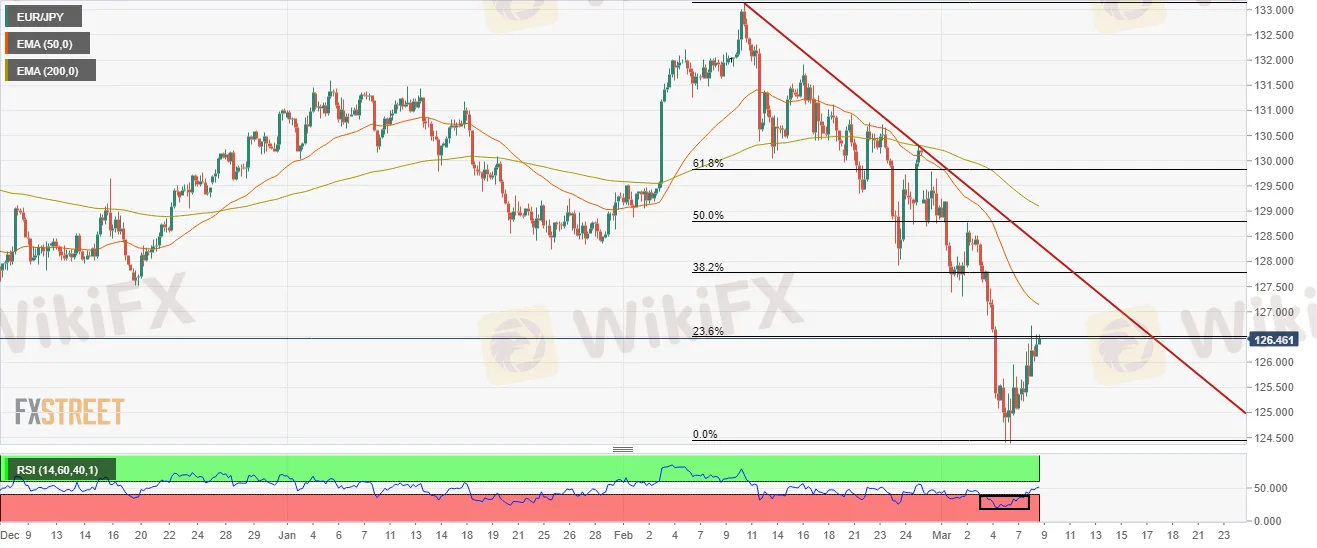简体中文
繁體中文
English
Pусский
日本語
ภาษาไทย
Tiếng Việt
Bahasa Indonesia
Español
हिन्दी
Filippiiniläinen
Français
Deutsch
Português
Türkçe
한국어
العربية
EUR/JPY Price Analysis: Struggles to breach 23.6% Fibo retracement at 126.50
Abstract:The EUR/JPY pair has remained in the grip of bears from February 10 after failing to breach its eight-month high at 133.50. The cross has sensed barricades near the trendline placed from the February 10 high at 133.15.

EUR/JPY is struggling to violate 23.6% Fibo retracement at 126.50.
The RSI (14) is likely to find resistance near 60.00 amid the broader bearish picture.
The shared currency awaits a violation of 126.73 for upside momentum.
On a four-hour scale, EUR/JPY is struggling to overstep a 23.6% Fibonacci retracement, which is placed from February 10 high at 133.15 to March 7 low at 124.39. Usually, a struggle near 23.6% Fibo retracement denotes a fresh corrective wave after an impulsive one.
The 50-period and 200-period Exponential Moving Averages are trading at 127.15 and 129.10 respectively, which have recorded a bearish crossover, which adds to the upside filters.
Meanwhile, the Relative Strength Index (RSI) (14) has surpassed 40.00 after oscillating in a bearish range of 20.00-40.00. The ongoing oscillator action is indicating that the RSI (14) may find resistance near 60.00 and will trade lower or consolidate.
As the asset is hovering around the 23.6% Fibo retracement, it is likely to address significant offers if the asset tumble below Wednesday‘s low at 126.12. This will grind the cross lower towards Tuesday’s low at 125.22 and Mondays low at 124.39.
On the flip side, a bullish momentum can be observed if the pair climbs above Tuesdays high at 126.73. A breach of 126.73 will send the cross towards the 50-EMA and 38.2% Fibo retracement at 127.15 and 127.80, respectively.
EUR/JPY four-hour chart

Disclaimer:
The views in this article only represent the author's personal views, and do not constitute investment advice on this platform. This platform does not guarantee the accuracy, completeness and timeliness of the information in the article, and will not be liable for any loss caused by the use of or reliance on the information in the article.
Read more

Unmasking the ‘Datuk’: The Anatomy of a RM638,205 Investment Scam
Authorities in Malaysia have launched an extensive investigation into a fraudulent stock investment scheme, which has resulted in losses amounting to RM638,205.

Unmasking the ‘Datuk’: The Anatomy of a RM638,205 Investment Scam
Authorities in Malaysia have launched an extensive investigation into a fraudulent stock investment scheme, which has resulted in losses amounting to RM638,205.

ATFX Enhances Trading Platform with BlackArrow Integration
ATFX integrates the BlackArrow trading platform, offering advanced tools for forex, crypto, and stocks with automation and real-time analytics for traders.

Exposing the Truth: What Happened with the Losses of Thousands of Dollars on the GlobTFX Platform?
The facts are clear and undeniably shocking—GlobTFX has caused significant financial losses to well-known traders in the Arab world. Eighteen victims have confirmed a total loss exceeding $22,372! But this is just the tip of the iceberg…
WikiFX Broker
Latest News
Germany's Election: Immigration, Economy & Political Tensions Take Centre Stage
WikiFX Review: Is IVY Markets Reliable?
Brazilian Man Charged in $290 Million Crypto Ponzi Scheme Affecting 126,000 Investors
ATFX Enhances Trading Platform with BlackArrow Integration
IG 2025 Most Comprehensive Review
SEC Drops Coinbase Lawsuit, Signals Crypto Policy Shift
Construction Datuk Director Loses RM26.6 Mil to UVKXE Crypto Scam
Should You Choose Rock-West or Avoid it?
Franklin Templeton Submitted S-1 Filing for Spot Solana ETF to the SEC on February 21
Scam Couple behind NECCORPO Arrested by Thai Authorities
Currency Calculator






